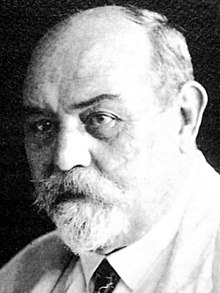Wilhelm Herrenknecht
Wilhelm Herrenknecht (born May 19, 1865 in Nonnenweier ; † March 4, 1941 in Freiburg im Breisgau ) was a German doctor , dentist and university professor .
Live and act
The Herrenknecht family comes from Allmannsweier and can be traced back to the 14th century. Wilhelm Herrenknecht was born as the seventh child of Johann and Barbara Herrenknecht. In 1886 he completed his school days with the Abitur at the Freiburg Berthold-Gymnasium . He then studied medicine at the universities of Freiburg and Munich until 1891 . "Treatment of carcinomatous stricture of the neck portion of the esophagus " was the theme of his Inaugural - Dissertation .
From 1891 to 1892 he worked as an assistant doctor at the Freiburg University Eye Clinic. In 1892 he went to the municipal hospital in Karlsruhe as an assistant doctor.
After he married Mathilde de Beauclair, a doctor's daughter from Freiburg on December 2, 1893, he settled as a general practitioner in Donaueschingen for six years .
From 1899 to 1900 he studied dentistry at the University of Strasbourg .
At the urging of the University of Freiburg , he completed his habilitation in 1903 on the subject of "ethyl chloride and ethyl chloride anesthesia" so that it could then begin its university career. On April 11, 1904, he was able to open the first Freiburg dental university institute, which he headed for 31 years until his retirement in 1934.
In the beginning, the equipment of the institute was very modest. In 1904 only seven oil pump chairs and three simpler wooden chairs were available for operations. Herrenknecht achieved that by 1912 additional treatment chairs, 20 pedal drills, an X-ray machine and more could be purchased. In addition, there was the equipment with sealing instruments and for dental work. Under the difficult circumstances described, Herrenknecht has managed in these 30 years to set up a modern clinic and a well-attended training facility that does not need to shy away from comparison with any other dental university institute and today plays a leading role in its field in Germany. His treatment successes were generally recognized, and many German and Swiss doctors and dentists visited "his" institute to familiarize themselves with the treatment methods practiced in the clinic.
Clinic operations during the First World War
During the First World War , the number of mouth and jaw injuries being treated at the same time rose to 120 people per day. The workload that weighed on Herrenknecht's shoulders in these four years is clearly demonstrated by the fact that up to June 1918 almost 700 wounded with jaw injuries and over 8,000 soldiers received treatment and help in more than 50,000 sessions at the dental polyclinic.
Teaching and Research
Wilhelm Herrenknecht was an excellent academic teacher who, above all, made real life pulsate in his teaching activities. In his lectures he placed particular emphasis on showing and clarifying the understanding of the close connections between general medicine and dentistry.
It is a well-known fact that proper dental care protects against tooth and oral cavity disease. Herrenknecht also pointed out the enormous importance of dental care as prophylaxis at an early stage . In 1910 he published an article in the Swiss quarterly journal for dentistry under the title "On the prophylaxis of dental caries ". In this publication he points out the enormous importance of dental care in clear lines that focus entirely on the essentials and underpins this with various bacterial-histological studies.
Herrenknecht can, however, also claim that he was one of the first to recognize that an infection originating from a focus of the disease can lead to a general disease , and this was proven by his own observations as early as 1910 (rheumatism healing through treatment of pulp-dead teeth ). He has shown how one can intervene in a therapeutically helpful manner in so-called focal diseases (focal toxicoses).
Professional representation
From 1926 to 1928 Herrenknecht was chairman of the “Central Association of German Dentists” (today “German Society for Dentistry, Oral and Maxillofacial Medicine eV (DGZMK)” ). Herrenknecht was a member of the NSDAP .
Awards
In 1920 the University of Freiburg awarded him the newly created Dr. med. dent. honoris causa .
literature
- Martin Frenk: Prof. Dr. med. et Dr. med. dent. hc Wilhelm Herrenknecht - A forgotten son of nuns , biography in: Martin Frenk: Riedprofile . Ottenheim 2004, pp. 37-50.
- Wolfgang Röder: Prof. Dr. med. Dr. med. dent. hc Wilhelm Herrenknecht (1865-1941) . Dissertation at the University of Cologne. Wasmund-Bothmann Publishing House, Cologne-Sülz 1970.
- August Gruber, K. Gerhardt: Reports of the Natural Research Society in Freiburg i. Br. (1952), Vol. 42-43, p. 48.
Web links
Individual evidence
- ^ Detlev Michael Albrecht: Contributions to Dresden University Medicine , 1999
- ↑ http://www.dgzmk.de/dgzmk/historie.html
- ^ Dominik Groß, Karl Frederick Wilms Dossier 2: The presidents of the DGZMK, the honorary members of the dental professional associations and their role in the "Third Reich" . Retrieved December 19, 2019.
| personal data | |
|---|---|
| SURNAME | Herrenknecht, Wilhelm |
| BRIEF DESCRIPTION | German doctor, dentist and university professor |
| DATE OF BIRTH | May 19, 1865 |
| PLACE OF BIRTH | Nunsweier |
| DATE OF DEATH | March 4, 1941 |
| Place of death | Freiburg in Breisgau |
